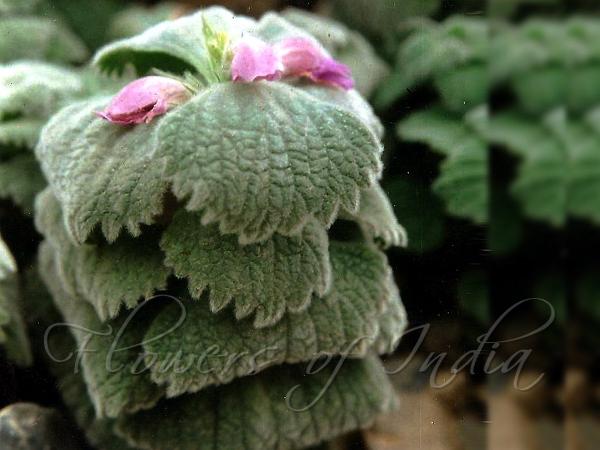|
| Alpine Deadnettle |
|

|

|
|
|
|
Photo: |
Botanical name: Eriophyton rhomboideum Family: Lamiaceae (Mint family)
Synonyms: Lamium rhomboideum, Alajja rhomboidea, Erianthera rhomboidea
Synonyms: Lamium rhomboideum, Alajja rhomboidea, Erianthera rhomboidea
Alpine Deadnettle is a high altitude perennial herb
with a creeping thick woody rootstock. Stems are few to several,
unbranched, slender at base with leaf-like scales, thicker above,
velvety to woolly with simple hairs, leafy, decumbent-ascending, 10-25
cm long. Leaves are often congested, broadly rhomboid-kidney-shaped,
upper larger than lower, about 3.5-5 cm long, 4-6 cm broad, variable in
woolliness from densely white woolly to velvety and almost hairless,
toothed, flat at base to broadly wedge-shaped. Leaf stalks on lower
leaves are broad, up to 2 cm below less above. Flowers are few, large,
4-8 in upper leaf axils, stalkless. Bracts are subulate, shorter than
calyces. Calyx is 1.5-1.8 cm long, woolly to velvety, tube straight,
herbaceous. Teeth are nearly equal lanceshaped, subulate-acuminate.
Flowers are 3-4 cm, velvety. Lower lip is equal to or longer than
upper. Nutlets are obovoid, smooth, about 5 mm. Alpine Deadnettle is an
unmistakable high alpine scree species. It is reported to have a strong
unpleasant smell. It is found in the Himalayas, from E. Afghanistan to
Himachal Pradesh, at altitudes of 4000-5000 m. Flowering: July-August.
| Identification credit: Krishan Lal | Photographed in Lahaul-Spiti distt., Himachal Pradesh. |
• Is this flower misidentified? If yes,